
FUJIWARA-NO-MIYA (694-710)
Special Historical Site
The Fujiwara-no-miya was a full-fledged Chinese-style palace constructed by Empress Jito as the capital of Japan's ritsuryo-administered nation-state. Centered on the present-day Takadono district of Kashihara-shi and surrounded on three sides by the "three Yamato mountains," the palace covered an area of approximately one kilometer per side. In the center was the dairi (sovereign's residential quarters) and the chodoin,an area with ministerial offices arrayed on either side of a central courtyard used for ceremonial activities. The outer perimeter of the palace was ringed with a tail wooden fence and a moat. On the present site of the former daigokuden (main audience hall, the most important building within the chodoin), vestiges of an elevated platform. in local parlance known as the"omiya dodan" ("earth platform of the great palace"), rise above the surrounding rice fields.
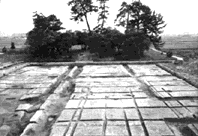
The omiya dodan as seen from
the site of the south gate.
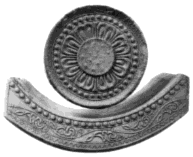
Tile from Fujiwara-no-miya
|
|
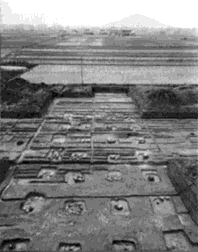
Remains of government offices.
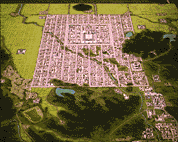
restoration model from Fujiwara-no-miya
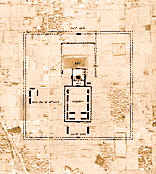
Excavated areas
|
THE FUJIWARA CAPITAL CITY
As well befit the head city of the ritsuryo nation-state, Fujiwara-kyo was patterned after the Chinese capitals. Here, for the first time in Japan, city streets were constructed in a checkerboard arrangement. The exact area of the capital city is not known, but it is thought to have extended approximately 2 kilometers from east to west and 3 kilometers from north to south,bounded on the east, west and north, respectively, by the Nakatsumichi, Shimotsumichi, and Yoko-oji, all three of which were important trunk roads of the time. The custom of calling the eastern half of the capital the "left capital" (sakyo) and the western half the "right capital"(ukyo) was in Japan first practiced at Fujiwara-kyo. City blocks, delineated by streets (oji), seem,in contrast to Nara-'kyo (Nara) and Heian-kyo (Kyoto), not to have been designated by numerical combinations of jo (north-south subdivisions) and bo (east-west subdivisions), but rather by proper names such as Ohari-machi or Hayashi-mach.
|
|
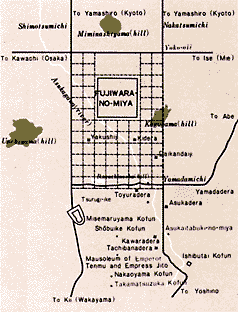
Map showing Fujiwara-kyo and surroundings, as reconstructed by Kishi Toshio.
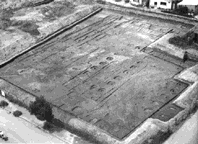
Remains of Fujiwara-kyo
|
HOUSEHOLD REGISTERS
Under the ritsuryo legal system, household registers (koseki) listing each person in the country were compiled to serve as the basis for levying taxes and conscripting soldiers. During the period of the Fujiwara capital when the ritsuryo system was being perfected, the principle was established of compiling household registers once every six years.
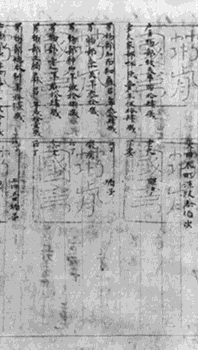
Part of a household register from Chikuzen-no-kuni (present-day Fukuoka-ken dating from the year 702. This is the oldest extant household register in Japan and is said to have been formerly housed in the Shosoin.
|
|
WOODEN TABLETS
As the ritsuyo legal system took shape, it became more and more common for government offices to use written records in the handling of administrative affairs. These written records took the form of wooden tables (mokkan) bearing ink-written Chinese characters such as those which have been discovered at the site of Fujiwara-no-miya and the supposed site of Asuka Itabuki-no-miya. The mokkan were of several types, including documents, labels for goods in transport, and tallies for other classification purposes. They provide important new materials for learning about the culture, finances, organization of government offices and overall administrative system of the time. For example, while it had been known that Japan in the Nara Period was divided into sixty-odd units known as kuni and each of these kuni was divided into several kori, it had not been known when the Chinese character that, during the Nara period, was used to represent kori, first came into use. Through an examination of recently excavated mokkan, it has been established that previous to the Taiho legal code (702),the word kori was written with a different character.
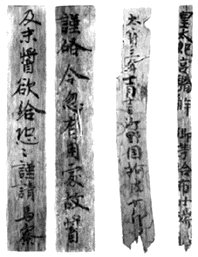
Two illustrations on left:
Reverse and obverse of the same mokkan. This tally was a communication by which one Yako-no-Oi. an immigrant official in the service of Princess Tajima (daughter of Emperor Tenmu), made a requisition for various quantities of three medicinal plants including obako fruit (a kind of plantain). used as a diuretic and cough medicine.
Right (above) :
Label attached to taxes in kind collected in 699 from Kazusa-no-kuni. Awa-no-kori (later Awa-no-kuni. in southern part of present-day Chiba-ken).
Right (below) :
Label attached to 7 kin (about 4.5 kilograms) of shoriku (a medicinal herb used as a diuretic).
|
|Asuka Period
|THE ASUKA PALACES
|ASUKA STONES
|ASUKA KOFUN|
|TAKAMATSUZUKA KOFUN
|THE ASUKA TEMPLES
|ASUKA AND THE MAN'YOSHU|
Copyright (c) 1995 ASUKA HISTORICAL MUSEUM All Rights Reserved.
Any request to kakiya@lint.ne.jp
Authoring: Yasuhito Kakiya
|